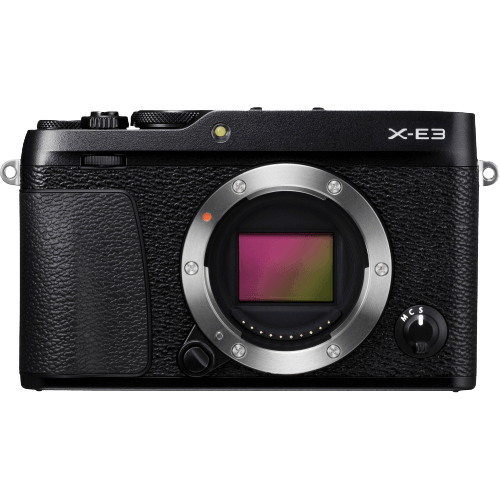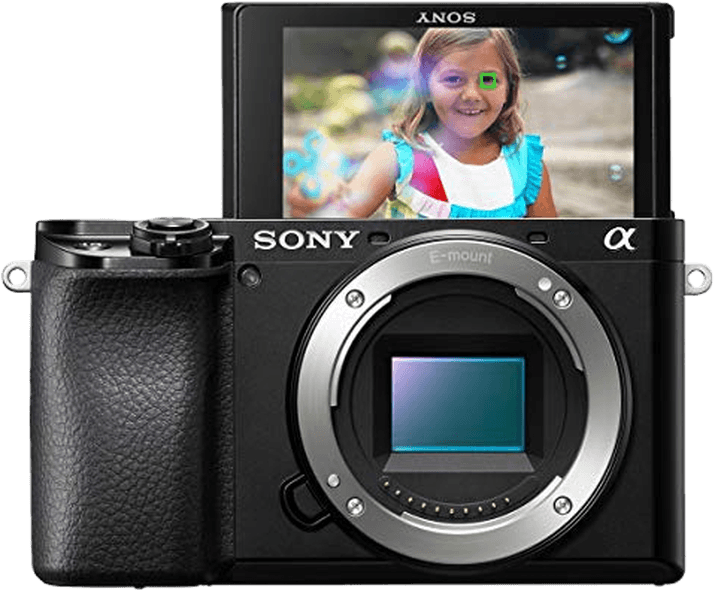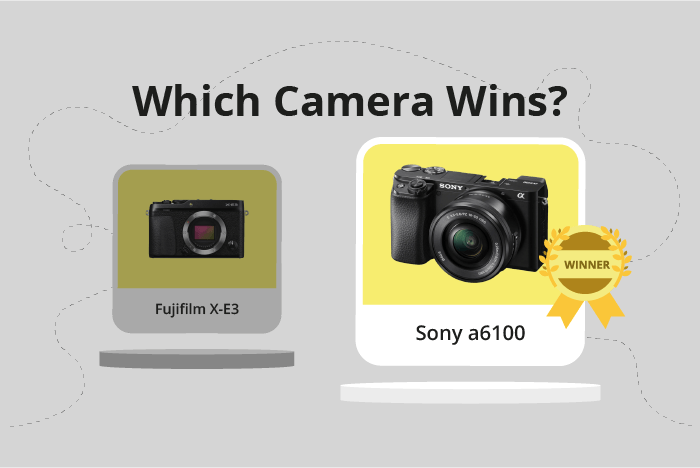Fujifilm X-E3 vs Sony a6100 Comparison
Fujifilm X-E3

Sony a6100

The Sony a6100 edges out the Fujifilm X-E3 with a score of 66/100 compared to 63/100. Both cameras are mirrorless and share similar dimensions, with the X-E3 measuring 121 x 74 x 43mm and the a6100 at 120 x 67 x 59mm. However, the X-E3 is lighter, weighing 337g, while the a6100 weighs 396g.
The Sony a6100’s advantage lies in its more recent release year (2019) and lower launch price ($750) compared to the X-E3’s 2017 release and $899 price tag. On the other hand, the Fujifilm X-E3 has the benefit of being more compact and lightweight.
Taking these factors into account, the Sony a6100 offers a better value with its more recent technology and lower price, while the Fujifilm X-E3 appeals to those who prioritize a lighter and more compact camera.
Fujifilm X-E3 vs Sony a6100 Overview and Optics
The Sony a6100 comes out on top in our optics comparison with a score of 68/100, while the Fujifilm X-E3 trails slightly behind with a score of 64/100. Both cameras share some common specifications like having 24 megapixels, a CMOS sensor, APS-C sensor size, and no image stabilization feature. They also have different lens mounts, with the Fujifilm X-E3 utilizing the Fujifilm X mount and the Sony a6100 using the Sony E mount.
The Sony a6100 edges out the Fujifilm X-E3 with its faster shooting speed of 11 frames per second (fps) compared to the X-E3’s 8 fps. Additionally, the a6100’s processor, the Bionz X, contributes to its superior performance. The Sony a6100 also holds a DXOMARK sensor score of 82, giving users an idea of its image quality, whereas Fujifilm cameras are not scored by DXOMARK.
Despite its lower score, the Fujifilm X-E3 has its own advantages. The X-Processor Pro, its image processor, ensures quality performance. Although DXOMARK does not score Fujifilm cameras, many users and professionals alike have praised the X-E3’s image quality and color rendition.
Taking these points into consideration, the Sony a6100 stands out as the better option in terms of optics, primarily due to its faster shooting speed and higher DXOMARK sensor score. However, the Fujifilm X-E3 remains a strong contender, offering excellent image quality and performance. Ultimately, the choice between these two cameras will depend on the user’s specific needs and preferences.
Fujifilm X-E3 vs Sony a6100 Video Performance
The Sony a6100 outperforms the Fujifilm X-E3 in video capabilities, with a score of 91/100 compared to the X-E3’s 69/100. Both cameras offer 4K video resolution and a maximum video dimension of 3840 x 2160. However, there are significant differences in their features that contribute to the Sony a6100’s higher score.
The Sony a6100 boasts a maximum video frame rate of 120fps, doubling the Fujifilm X-E3’s 60fps. This superior frame rate allows for smoother slow-motion footage and enhanced video quality. Additionally, the a6100 has built-in time-lapse functionality, providing users with a creative and comprehensive video toolset.
While the Fujifilm X-E3 falls behind in these aspects, it still delivers solid video quality with its 4K resolution and 60fps frame rate. However, it lacks the advanced features and versatility found in the Sony a6100.
Considering the video capabilities of both cameras, the Sony a6100 emerges as the clear winner due to its higher frame rate and built-in time-lapse functionality. The Fujifilm X-E3, while offering good video quality, does not match the a6100’s impressive performance and features. Users seeking a camera with strong video capabilities should opt for the Sony a6100 to fully benefit from its superior performance.
Fujifilm X-E3 vs Sony a6100 Features and Benefits
The Fujifilm X-E3 emerges as the winner in this comparison, scoring 70/100 in features, while the Sony a6100 scores 68/100. Both cameras share several common specifications, such as a 3-inch screen size, touchscreen capabilities, and the absence of GPS. Furthermore, both cameras are equipped with WIFI and Bluetooth connectivity.
The Fujifilm X-E3 outperforms the Sony a6100 with its higher screen resolution of 1,040,000 dots, compared to the a6100’s 921,600 dots. This difference provides the X-E3 with a sharper and clearer display, allowing for better image preview and easier menu navigation.
On the other hand, the Sony a6100 has a flip screen, a feature that the Fujifilm X-E3 lacks. This flip screen offers added versatility for capturing images or videos from various angles, making it a valuable asset for vloggers and content creators.
Despite the Fujifilm X-E3’s lead in the overall feature score, the Sony a6100’s flip screen proves to be a notable advantage in certain situations. Thus, potential buyers must weigh the importance of a higher screen resolution against the benefits of a flip screen when choosing between these two cameras.
Ultimately, the Fujifilm X-E3 offers superior screen resolution, while the Sony a6100 provides a versatile flip screen. The choice between these two cameras depends on individual preferences and the intended use of the camera.
Fujifilm X-E3 vs Sony a6100 Storage and Battery
The Sony a6100 outperforms the Fujifilm X-E3 in storage and battery with a score of 37/100, compared to the X-E3’s 21/100. Both cameras have one memory card slot and are compatible with SD, SDHC, and SDXC cards. The a6100 also accepts Memory Stick Pro Duo cards, giving it an edge in storage versatility.
The Sony a6100’s battery life is longer at 420 shots, while the Fujifilm X-E3’s battery life is 350 shots. Additionally, the a6100 has USB charging, whereas the X-E3 does not. This makes the a6100 more convenient for charging on the go.
Despite the X-E3’s lower score, it still provides a decent battery life and storage options for photographers. However, the Sony a6100’s additional storage compatibility, longer battery life, and USB charging capability make it the superior choice in this category.
Alternatives to the Fujifilm X-E3 and Sony a6100
Are you still undecided about which camera is right for you? Have a look at these popular comparisons that feature the Fujifilm X-E3 or the Sony a6100:

